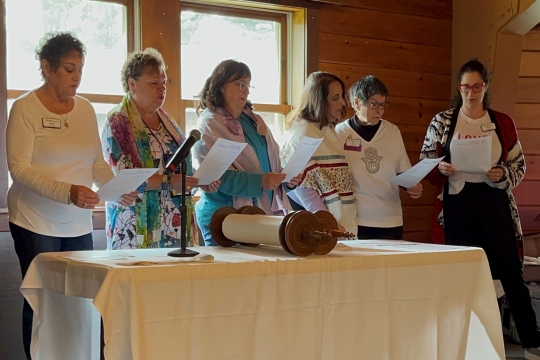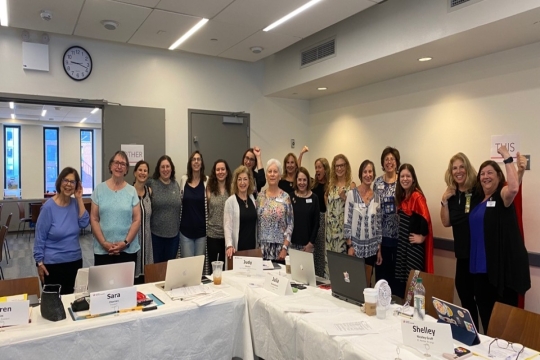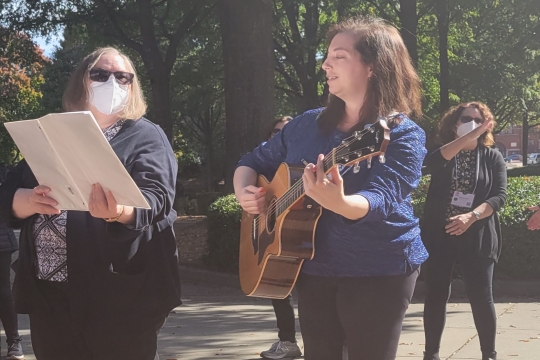by Deborah Radin
This week’s parashah, Tazria, translates to “she conceived” or “she gives birth”. And yet the text focuses not on the birth but on regaining purity after giving birth, also describing various skin diseases and the rules of ritual purity relating to those ailments. It is a difficult portion to read and to relate to our modern sensibilities. How did a Torah portion with such a beautiful, promising title turn into a discussion of purification rituals after childbirth? In an attempt to answer this question, I want to go back to the beginning.
Conception is a beginning. The infant is innocent and unaffected. In such a susceptible state, the child has the potential to mature into a kind, caring, positive person, or can instead become difficult, unhappy, and negative. As the mother, while I do not have sole influence, my actions are significant in determining the kind of person my child will become.
Like a newborn child, a new organization is un-formed and ready to be influenced. The founders have the power to decide, from the beginning, whether to be forces of good or harm, healing or destruction. They control the energy that dwells within its midst. Tazria teaches that we can control our environment and how we act within it. While that which is pure may become tainted, we can direct the eventual outcome.
My sisterhood recently completed an almost three-year effort to review our bylaws. Our bylaws had not been updated since their inception in 1960, and the project started as a way to provide some structure to a very big organization with many responsibilities, performed by many volunteers. But what began as a singular task developed into a complete rewrite of our historic rules. Although unaware at the time exactly where we were headed, the path to amend the bylaws led also to collective soul-searching and questioning what we do as an organization and as volunteers, how we do it, and why. Along the way, our board revisited our mission statement, and developed our first-ever board member job description. We redefined who we are as an organization, our purpose and place within our temple community, and who we strive to be.
While doing research for this project, I came across a 1969 newsletter article written by our sisterhood president at the time. In what was a fundraising plea, she noted that “this is one of the few years we have not bombarded you with a lot of fundraising affairs. However, our financial obligations go on just the same and must be met by the end of the year. Our commitments to the Temple are many–Religious School Festivals, Oneg Shabbats, Youth Group Director’s salary, Building Fund pledge, Camp Swig camperships, Confirmation Bibles, and many, many more.” Pondering her words, I realized that almost 50 years later, our sisterhood still thrives, supporting many of these same commitments as well as other vital programs and services that have come to the fore since then. Our sisterhood has grown along with our temple, from an intimate community to one with hundreds of members. I would like to think that all of this work happens organically, and that our many volunteers help sustain each other and our community effortlessly. But the reality is that our volunteers also require support—they need the organization, resources, mentoring and friendship of others, so that when they commit to making a difference, they can succeed. From the beginning, our sisterhood chose to seek opportunities to do good, fulfilling work and while not always easy to do, we continue those efforts today.
So this difficult Torah portion teaches us something very important: Each of us has the tools within us to make choices and affect change. Conception is a beginning. We start with something beautiful and unblemished, and we can influence its future. Our 1960 bylaws were a beginning, and with the completion of the 2016 rewrite, we continue the legacy of tikkun olam and tzedakah given to us by our foremothers decades ago, and provide support for those who will continue that legacy into the future.
Deborah Radin is immediate past president of Beth Am Women, from Los Altos Hills, CA. She has recently joined the WRJ Board, and is participating in the WRJ Wilkenfeld International Women’s Leadership Seminar.
Related Posts
Image

Parashat Yom Rishon shel Rosh HaShanah
September 14, 2023
During the High Holidays, my thoughts turn to the special blessings, prayers, and melodies that shape our journey from Selichot to Rosh HaShanah to the final shofar blast on Yom Kippur. Many of our prayers in the High Holiday liturgy are written in the plural.
Image

Cultivating a Culture of Accountability and Belonging
September 8, 2023
And, we’re off! Many of us have worked over the summer with friends and colleagues to set the calendar for the year ahead, including meetings, events, and other opportunities for gathering.
Image

My Journey from Altar-Girl to Cantorial Soloist
August 11, 2023
I was born a Goldman, and always knew I was Jewish on my dad’s side. Although my whole family was spiritual in their own way, the Jewish side of my family didn’t have warm feelings towards religion, and the only thing passed down to me was the Jewish humor I grew up in New Jersey and had an open...
